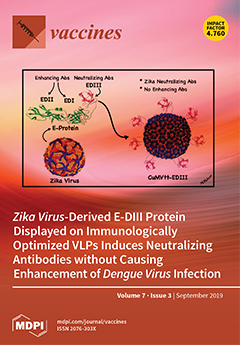This work describes immunization of European sea bass (
Dicentrarchus labrax) juveniles against viral nervous necrosis virus (VNNV), a
betanodavirus causing worldwide mortalities in many fish species. Protection was obtained with the so-called spinycterin vehicles consisting of irreversibly DNA-damaged DNA-repair-less
Escherichia coli
[...] Read more.
This work describes immunization of European sea bass (
Dicentrarchus labrax) juveniles against viral nervous necrosis virus (VNNV), a
betanodavirus causing worldwide mortalities in many fish species. Protection was obtained with the so-called spinycterin vehicles consisting of irreversibly DNA-damaged DNA-repair-less
Escherichia coli displaying at their surface a downsized VNNV coat antigen. In this work we have (i) maximized bacterial expression levels by downsizing the coat protein of VNNV to a fragment (frgC
91–220) containing most of its previously determined antigenicity, (ii) developed a scalable autoinduction culture media for
E. coli based in soy-bean rather than in casein hydrolysates, (iii) enriched surface expression by screening different anchors from several prokaryotic sources (anchor + frgC
91–220 recombinant products), (iv) preserved frgC
91–220 antigenicity by inactivating bacteria by irreversible DNA-damage by means of Ciprofloxacin, and (v) increased safety using a repair-less
E. coli strain as chassis for the spinycterins. These spinycterins protected fish against VNNV challenge with partial (Nmistic + frgC
91–220) or total (YBEL + frgC
91–220) levels of protection, in contrast to fish immunized with frgC
91–220 spinycterins
. The proposed spinycterin platform has high levels of environmental safety and cost effectiveness and required no adjuvants, thus providing potential to further develop VNNV vaccines for sustainable aquaculture.
Full article






